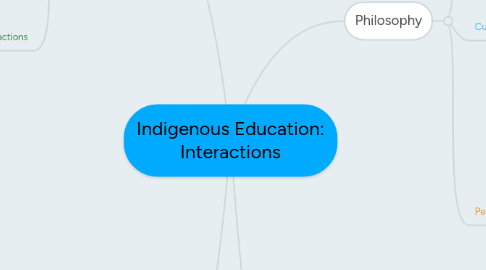
1. Sociology
1.1. Contemporary Conflict
1.1.1. the parameters of concepts such as ethnicity, race, gender and class are subject to change in space and time its important to look at history, but also the contemporary. (Ghosh, 2008)
1.1.2. There is still currently a lot of misconceptions and stereotypes on who is an 'indian" (King, 2003)
1.1.3. We (canadian society) have perpetuated ideas of how education should function as a standard view, when often Indiginous groups disagree with colonial forms of education.
1.1.4. "Often teachers, perhaps inadvertently, exacerbate existing power inequities by reinforcing social attitudes through their own prejudices and stereotypical assumptions about student capabilities and cultural behavior. Low expectations, for example, are likely to result in self-fulfilling prophecies." (Ghosh, 2008)
1.2. Societal Interactions
1.2.1. Anuik talked a lot about how government personnel in Saskachewien started to see Métis learners as "culturally different" pupils who needed to learn how to cope with social and economic change, but Métis families had no control over education in their communities.(Anuik, 2010)
1.2.2. "The school is a microcosm of society, and a racist society will exhibit power struggles in school."(Ghosh, 2008)
1.2.3. A big problem was the settler populations had not understood the differences held by Métis and non-Métis society over the value of schools for their children and youth. (Anuik, 2010)
1.2.4. The Canadian Government is recognizing that First Nations deserve more control over education. However; the Government is doing things FOR First Nations rather than WITH. (Roman, 2014)
1.2.5. Indigenous students often feel that the should fit a certain image, as it is culturally appropriated in the media, and in contemporary objects. (King, 2003)
1.2.6. In Atleo's opinion (which i definitely agree) is we should not put an emphasis on Euro-herithige because its an assimilationist model, or an Emphasis on Aboriginal heritage because that becomes an Accommodationalist model. instead we should work together in a constructivist/ Dialogical model
2. History
2.1. Education History
2.1.1. The departure of children and youth from their communities represented a chance for them to become citizens of the modern state of Canada. (Anuik, 2010)
2.1.2. Residential School, "educating the 'indian' out of the boy.
2.1.3. History of Education being underfunded for aboriginal students when compared to non-aboriginal students. (Roman, 2014)
2.1.4. Historically Indigenous culture was alienated in Curriculum. (Atleo 2013)
2.2. Colonial History
2.2.1. "Violence against Aboriginals has continued from the time of conquest."(Ghosh, 2008)
2.2.2. "failing to recognize Canada's racist history and portraying a race-less and colour-blind society condones and continues white privilege (white racism)." (Ghosh, 2008)
2.2.3. Assimilation policies i.e.. Indian Act
2.2.4. Indigenous populations have been stricken with ideas of sovereignty, colonial violence, and lateral violence (Roman, 2014)
2.2.5. Indigenous populations were oppressed through conquest and adversely effected by being either demonized, or romanticized. (King, 2003)
3. Philosophy
3.1. Racism & Discrimination
3.1.1. "Teachers could not simply reinforce socioeconomic and racial differences through the use of prescriptive textbooks. They had to facilitate intellectual and social growth in the classrooms of the province."(Anuik, 2010)
3.1.2. skin colour, facial features, dress, and language can each have a dramatic impact on an individual's lived experiences.(Ghosh, 2008)
3.1.3. "racist and sexist materials have largely been removed from formal curricula, although the problem of Eurocentric educational systems across Canada does produce racist effects, largely through textbooks' non-recognition and mis-recognition of the contribution of groups of people."(Ghosh, 2008) i.e. hidden curriculum! teachers may come into classrooms with preconceptions of what aboriginal students think and act.
3.2. Cultural Relationship
3.2.1. In Sasakachiewen the voices of "Métis families did not emerge in any policy discussions despite the attempts on the part of the Departmental officials to build school environments, pedagogy, and curriculum that reflected Aboriginal perspectives on the history of Canada." (Anuik, 2010)
3.2.2. there is a move to building and strengthening the relationship in Canada by increasing funding, and respect, (which is arguable). (Roman, 2014)
3.2.3. Cross-cultural living can be a tool to construct a positive and enhance a multicultural model. (Atleo, 2013)
3.3. Pedegology/ Paradigm changes
3.3.1. "The problem in the classroom of non-readers and non-speakers may be due to the fact that the classroom incorporates none of the situations or aspects that would evoke a linguistic outpouring from these groups of people or other people from communities where a nonstandard dialect of English is used."(Anuik, 2010)
3.3.2. "There is a need for more social studies material that is unbiased and which positively portrays Northern and Indian/Metis life-past and present."(Anuik, 2010)
3.3.3. "School and the rest of society need to work together towards the human ideal of a more just, violence-free and interdependent world."(Ghosh, 2008)
